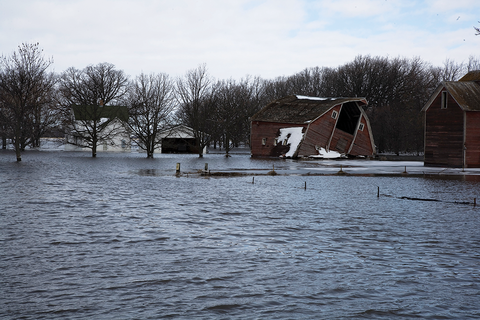Quick facts
- Dealing with the damage to livestock structures due to severe weather is stressful.
- Before immediately jumping in and making repairs, consider all your options.
- Be safe before attempting temporary repairs.
- Inspect different structures for damage, and wait to settle with your insurance company until you feel all repairs are known or made.
What to do with damaged livestock structures
Having a tornado, straight-line winds or flood occur at your animal production site can be a very traumatic experience, especially if you live at the site and there were both property and livestock losses. After the initial shock, livestock and poultry producers are now facing major decisions concerning those partially—or totally—destroyed buildings.
Instead of quickly fixing up the damaged facility or rebuilding a new unit on the same site, stop for a while and ask yourself several questions:
- Do I (and others in the operation) want to continue raising livestock on this farmstead?
- How much will it cost to repair the damage to the existing building?
- If building new, should the unit be located where the old barn stood?
- What about manure handling? Is there room to construct a larger barn? Is this farmstead too small for any more buildings?
All of these questions and more have probably crossed your mind if you have experienced storm or flood damage. Although the storm/flood was tragic, try to look at it as an opportunity to improve your facilities. This may be a way to streamline a pig flow problem, consolidate your manure handling, expand a dairy operation or relocate a facility to a more desirable site.
Answers to many of these questions are difficult but need to be made with as much information as possible as soon as possible. Decisions about staying in the livestock business may be the easiest to make. Deciding to build new or fix the old unit should be made after getting some solid bids on renovating costs. It is probably better to start from scratch if the cost of repair is more than two-thirds of the cost of a new barn. The other questions fall under general farmstead planning and design concepts for facilities. A good source for this information is the MidWest Plan Service (MWPS).
Consultant
Unfortunately, most of the information you need at this critical time is going to be specific to your situation. The general guidelines that you may find are only that: guidelines. Don’t be afraid to seek outside opinions plus consultants’ input. A $500 to $1,000 investment for planning services could, and probably will, save you thousands of dollars if the building “system” is not put together properly.
Inspecting farm building roofs for damage
Damaged or missing shingles
Check asphalt shingles for cracks at the butt end, where they may have been weakened from flexing. Make sure individual shingles have not blown off. Thoroughly inspect shingles on the ridge, gable ends and eaves.
Loose nails on metal roofing
Inspect the entire roof, with particular attention to gable ends, eaves and ridge cap. If nails have worked loose, re-nail them as soon as possible. If the nails don't hold when hammered back in, use #12 or #14 metal screws to fill old nail holes. Use aluminum screws on aluminum and steel screws on steel. Renail three to four inches away with ring or screw-type nails.
Potential leaks
On a sunny day, check the roof carefully from inside with the building doors closed. While looking for holes in the roof, inspect the ridge, gable ends and eaves for possible structural separation.
Assessing roof damage
Working with your insurance company
The sooner you talk to your agent, the sooner your claim will be filed and your property inspected. Don't be in a hurry to settle your insurance claim. Instead, keep your insurance agent apprised of repair estimates and repair. Only settle your claim when you feel all repairs are known and/or made.
Temporary repairs
If temporary repairs are needed before the professionals arrive, be sure that only a physically able person is allowed on the roof. If the roof is sagging from structural damage, wait for a professional; a sagging roof may collapse. Cover holes in the roof, walls, or windows with boards, tarps or plastic sheeting. If possible, place tarps or plastic around the ridge so rain rolls off. Nail down plastic sheets or trash bags with strips of wood and secure them with duct tape. If the holes are large, support the plastic in the center to keep it from ripping from the weight of the rain.
Inspecting the foundation, silo and interior
Foundation
The plate should not be separated from the studding where the foundation meets the walls. On block foundations, inspect mortar joints to make sure the block with the plate bolt in it hasn't separated from the wall. On stone or concrete foundations, check to see that the plate bolts have not worked loose.
Silo
Make sure the silo is still plumb. Look for loose hoops. Inspect the roof to be sure it remains fastened to the silo. Inspect the base of the metal silos inside and outside for hairline cracks. If there is rust around the base, remove it with a wire brush. Then check for cracks and apply a rust preventive paint. Look for new cracks in the plaster of empty concrete stave silos.
Interior
Inspect the interior of buildings for structural damage. Using a good light, check the framing. Look for ridge separation, loose knee braces and loose rafters where the rafters join the walls.
University of Wisconsin Cooperative Extension
Reviewed in 2024


